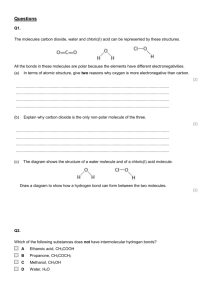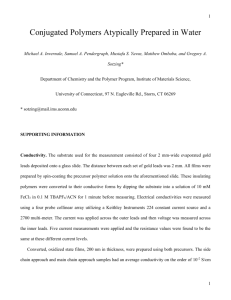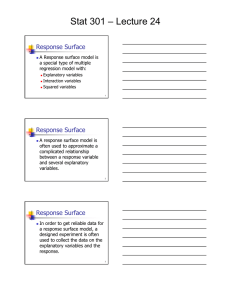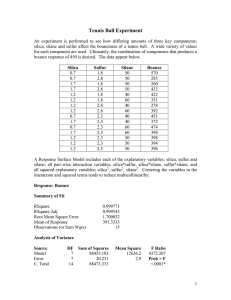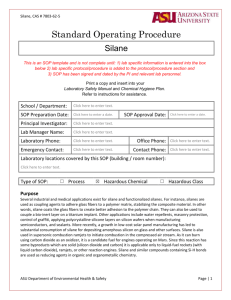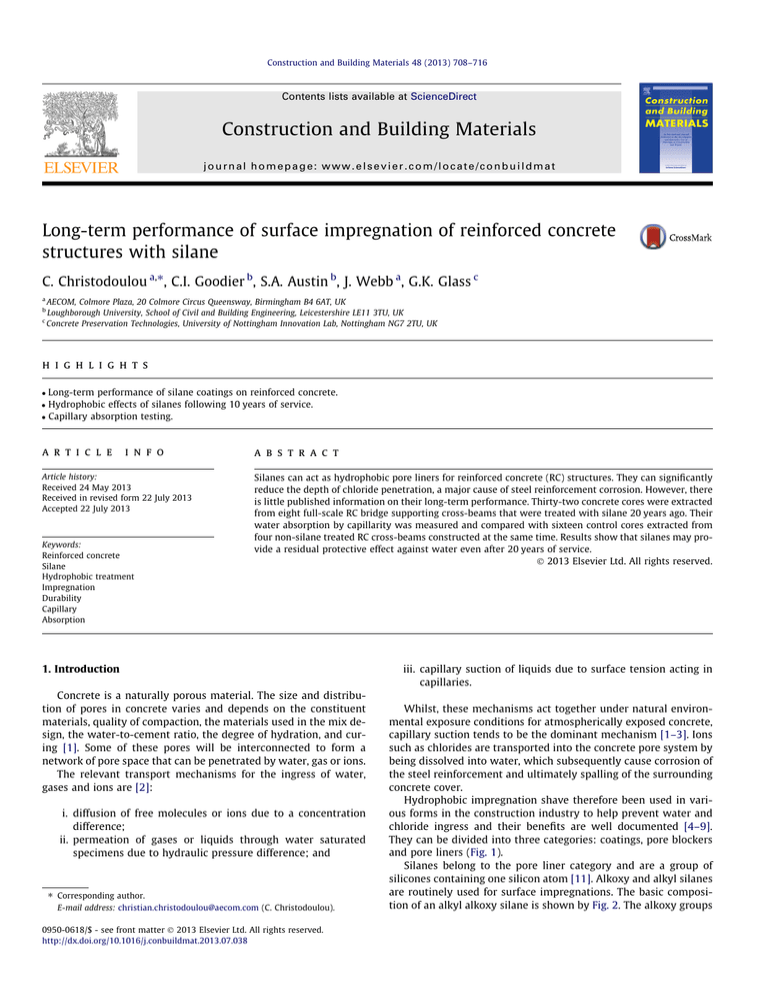
Construction and Building Materials 48 (2013) 708–716
Contents lists available at ScienceDirect
Construction and Building Materials
journal homepage: www.elsevier.com/locate/conbuildmat
Long-term performance of surface impregnation of reinforced concrete
structures with silane
C. Christodoulou a,⇑, C.I. Goodier b, S.A. Austin b, J. Webb a, G.K. Glass c
a
AECOM, Colmore Plaza, 20 Colmore Circus Queensway, Birmingham B4 6AT, UK
Loughborough University, School of Civil and Building Engineering, Leicestershire LE11 3TU, UK
c
Concrete Preservation Technologies, University of Nottingham Innovation Lab, Nottingham NG7 2TU, UK
b
h i g h l i g h t s
Long-term performance of silane coatings on reinforced concrete.
Hydrophobic effects of silanes following 10 years of service.
Capillary absorption testing.
a r t i c l e
i n f o
Article history:
Received 24 May 2013
Received in revised form 22 July 2013
Accepted 22 July 2013
Keywords:
Reinforced concrete
Silane
Hydrophobic treatment
Impregnation
Durability
Capillary
Absorption
a b s t r a c t
Silanes can act as hydrophobic pore liners for reinforced concrete (RC) structures. They can significantly
reduce the depth of chloride penetration, a major cause of steel reinforcement corrosion. However, there
is little published information on their long-term performance. Thirty-two concrete cores were extracted
from eight full-scale RC bridge supporting cross-beams that were treated with silane 20 years ago. Their
water absorption by capillarity was measured and compared with sixteen control cores extracted from
four non-silane treated RC cross-beams constructed at the same time. Results show that silanes may provide a residual protective effect against water even after 20 years of service.
Ó 2013 Elsevier Ltd. All rights reserved.
1. Introduction
Concrete is a naturally porous material. The size and distribution of pores in concrete varies and depends on the constituent
materials, quality of compaction, the materials used in the mix design, the water-to-cement ratio, the degree of hydration, and curing [1]. Some of these pores will be interconnected to form a
network of pore space that can be penetrated by water, gas or ions.
The relevant transport mechanisms for the ingress of water,
gases and ions are [2]:
i. diffusion of free molecules or ions due to a concentration
difference;
ii. permeation of gases or liquids through water saturated
specimens due to hydraulic pressure difference; and
⇑ Corresponding author.
E-mail address: christian.christodoulou@aecom.com (C. Christodoulou).
0950-0618/$ - see front matter Ó 2013 Elsevier Ltd. All rights reserved.
http://dx.doi.org/10.1016/j.conbuildmat.2013.07.038
iii. capillary suction of liquids due to surface tension acting in
capillaries.
Whilst, these mechanisms act together under natural environmental exposure conditions for atmospherically exposed concrete,
capillary suction tends to be the dominant mechanism [1–3]. Ions
such as chlorides are transported into the concrete pore system by
being dissolved into water, which subsequently cause corrosion of
the steel reinforcement and ultimately spalling of the surrounding
concrete cover.
Hydrophobic impregnation shave therefore been used in various forms in the construction industry to help prevent water and
chloride ingress and their benefits are well documented [4–9].
They can be divided into three categories: coatings, pore blockers
and pore liners (Fig. 1).
Silanes belong to the pore liner category and are a group of
silicones containing one silicon atom [11]. Alkoxy and alkyl silanes
are routinely used for surface impregnations. The basic composition of an alkyl alkoxy silane is shown by Fig. 2. The alkoxy groups
709
C. Christodoulou et al. / Construction and Building Materials 48 (2013) 708–716
Fig. 1. Categories of surface impregnations : (a) coatings, (b) pore blockers and (c) pore liners [10].
Fig. 2. Typical alkyl alkoxy silane molecular structure.
(CH3O) linked to the silicate atom (Si) contain silicon–oxygen
bonds that will bond to silicates present in the concrete. The
organic alkylic (CH3) group remaining will protrude from the pore
structure and are responsible for the hydrophobic characteristics
[5,6].
Evidence from numerous studies demonstrate that the application of silanes significantly reduces water uptake, which as a result
reduces the ingress of chlorides and hence also reduces the corrosion risk to the reinforcement [6,9,12–18]. However, their performance is affected by surface imperfections, cyclic wetting and
drying, skill of the applicator, surface preparation, application rates
and local environmental conditions at the time of application.
Polder and de Vries [19] demonstrated that silane treated specimens still had a residual protective effect even after 5 years of
outdoor exposure in the Netherlands, by measuring the water
absorption and chloride content. In a similar study, Schueremans
et al. [20] demonstrated the protective effects of silanes after
12 years of exposure in an aggressive marine environment on a
RC quay-wall in a port in Belgium by measuring their chloride
content.
Work by the Transport Research Laboratory [21,22] in the UK
indicated that silanes were reasonably effective in reducing
chloride ingress into concrete structures based upon a review of
principal inspection reports, various Managing Area Contractors,
laboratory testing, and testing of cores extracted from full-scale
motorway RC structures. The performance of the silanes was tested
primarily by means of water absorption and sorptivity, but the age
of silane at time of testing was limited to 5 years.
From all of the above it is apparent that very little is known
regarding the durability of silane impregnations and their longterm residual protection (i.e. following at least 10 years of service).
Very commonly their performance is assessed by measuring chloride contamination at various depths over time. However, this is
only an indirect method and does not provide information on the
residual hydrophobic effect against water uptake. Extracting cores
for laboratory testing from full-scale structures is neither desirable
nor always feasible.
The objective of this study was to address this gap in knowledge,
improve our understanding of the efficacy and long-term service life
of silane impregnations by undertaking testing of full-scale RC structures. The findings will help contribute towards the development of
new improved corrosion management strategies and assist in a more
accurate whole life cost assessment of silane impregnations. The
findings also provide additional information regarding the maintenance requirements of RC structures with an existing silane impregnation . Early results of this work have also been reported [23].
2. Methodology
This section presents the basic theory, selection strategy for the cross-beams,
the properties of the concrete investigated, and the test methods applied including
their selection criteria.
2.1. Capillary theory
The transport of chlorides into concrete is governed by a mixed mode of capillary absorption of water and diffusion. Capillarity absorption can be defined as the
transport of liquids in porous and non-saturated solids due to surface tension acting
in capillaries and without appreciable external pressure [2]. For short-term contact
between the liquid and the porous solid surface, a non-steady-state transport
mechanism exists. This resembles conditions encountered on site by atmospherically exposed full-scale RC structures. It can be measured as the increase in mass
due to capillary water absorption as a function of the square root of time and it
is usually termed as rate of absorption. It can be also expressed as the increase in
volume as a function of the square root of time which, termed sorptivity.
Diffusion can be defined as the transfer of mass by random motion of free molecules or ions in a pore solution resulting in a net flow from regions of higher concentration to regions of lower concentration [2,24].
Concrete in contact with a salt solution will become contaminated with chlorides primarily due to capillary absorption rather than diffusion alone. Absorbed
chlorides can continue to penetrate by diffusion but at a significantly lower movement rate. Thus, measuring the rate of absorption (or sorptivity) can provide useful
information on the condition of silane impregnations.
The rate of water absorption can be expressed by Eq. (1) [2]. Sorptivity is the
uni-axial one-dimensional capillary absorption and can be expressed by following
equation [2]:
Rate of water absorption ¼
Sorptivity ¼
Vw
pffiffi
ðAc t Þ
0:5
m=h
Ww
pffiffi
ðAc tÞ
kg=m2 =h
0:5
ð1Þ
ð2Þ
where Ww (g) is the weight gained by the specimen, Ac (mm2) the surface area of the
specimen in contact with the water, t (s) the time of exposure and Vw (mm3) the volume of water absorbed.
710
C. Christodoulou et al. / Construction and Building Materials 48 (2013) 708–716
Measurement of water sorptivity can also be related to the rate of chloride
absorption [10,25].
Table 1 provides a summary of the European Standard BS EN 13057 [26] for
measurement of the capillary water absorption of hardened concrete.
Correction factor ¼
V
ðAc 12:5Þ
ð3Þ
where V (mm3) is the volume of the specimen and Ac (mm2) the surface area of the
specimen in contact with water.
2.2. Cross-beams
2.3. Testing
Fig. 3 illustrates a typical sub-structure arrangement of the motorway bridge
supporting cross-beams that were examined during this study. Silanes have been
applied to a total of 135 similar cross-beams across the UK’s Midland Link Motorway Viaducts (MLMV). Of these, 93 cross-beams were located in the viaduct that
was chosen for these investigations, whereas the remaining were distributed
amongst four other viaducts.
The methodological procedure employed is outlined in Fig. 4. The cross-beams
were constructed between 1968 and 1970, although the exact date is not known.
Thus, 1969 is used as the average construction year for calculations of age of silane
at time of testing. Although specimens were extracted from cross-beams of the
same viaduct, hence suggesting that at least comparable concrete was used, due
to the nature of construction, there will be variations in the overall concrete quality.
Due to the age of the cross-beams, there were no historical records available providing information on concrete mix design such as maximum aggregate size. Such details could have been approximated by petrographic analysis however this was
consider outside the scope of the current study and would have required a large
number of additional site cores.
Twelve cross-beams were selected, of which eight had previously received a silane impregnation 20 years following their construction, whereas the remaining
four had not, hence were acting as control specimens (Table 2). Variations in the
performance of specimens extracted from the control cross-beams could give an insight with regards to site variations in concrete quality. The chemical composition
of the silane impregnation was isobutyl trimethoxy silane. No historical records exist detailing the exact surface preparation procedures, application rates or weather
conditions at the time of the application, important factors that can affect silane
performance.
Four cores (diameter and length of 80 mm) were extracted from each crossbeam, all from the top surface, which represented the most critical area for water
ingress (Fig. 5). This residual risk can be attributed to the simply supported articulation arrangement of the bridges with carriageway expansion joints above every
cross-beam that were known to be susceptible to water leakage. After coring, each
core hole was carefully repaired with a shrink-resistance compensating repair
mortar.
A correction factor in accordance with BS 1881-122 [27] was applied to normalise the cores into an equivalent of 75 mm diameter and to eliminate minor differences in length between the cores as a result of the coring process:
A very common testing regime to evaluate the performance of silanes is to measure chloride penetration profiles between silane and control treated specimens
[19,20,22]. One differentiating factor of this work is that this approach was not employed. The cross-beams were silane treated after approximately 20 years of service
life and there were no historical records of the chloride levels at the time of silane
application. As such, there would be no previous information to compare against
and it was thus deemed that chloride concentration testing had limited potential
for investigating the efficiency of the silane impregnations and it required destructive testing of the valuable core specimens.
Investigation of the effectiveness of the silane impregnation as a chloride barrier was therefore conducted by measuring the capillary absorption, a non-destructive technique. Two sets of tests were undertaken: the first on the original silane
treated and control cores and the second on a subset of these to which a new silane
was applied. This subset created additional background information on what could
have been the potential effectiveness of silanes on aged concrete when the silanes
are young. As the original silane proprietary product (based on isobutyl trimethoxy
silane) was no longer commercially available, a frequently commercially available
silane product was used instead. The properties of the new silane are summarised
in Table 3. In the study by Calder and McKenzie [22] it is reported as product 2.3.
The procedure outlined by BS EN 13057 [26] was adopted with the following
changes:
i. The diameter of the cores was reduced to 80 mm and their length increased
also to 80 mm. This change was required in order to be in a position to
extract cores from full-scale RC cross-beams which are heavily reinforced.
ii. The cores were oven dried at 35 °C as opposed to the recommended 40 °C.
The drying temperature was lowered in order to minimise potential damage to the chemical structure of the residual silane impregnations.
iii. The drying period was extended until the weight loss of the specimens (due
to moisture loss) became stabilised to less than 0.05% weight loss over a
period of 2 days, as opposed to the r not greater than 0.2% in 2 h. This aimed
to minimise any effects on the sorptivity due to initial water content of the
specimens as a result of their greater length.
iv. All but the test face (silane treated face) were sealed against sideways
ingress of water and evaporation of moisture with a proprietary polysulphide sealant. This approach is in line with the recommendations of Kropp
Table 1
Standard test method for the determination of water absorption of concrete.
Standard
Output properties
Testing time
Specimen size
BS EN 13057
[26]
Sorption coefficient kg/m2h0.5
or m/h0.5 (i.e. Eqs. (1) and (2) respectively)
Intervals of 12 min, 30 min, 1 h, 2 h, 4 h
and 24 h are appropriate in most cases
Diameter (100 ± 5) mm
Length (25 ± 0.5) mm
Fig. 3. Typical sub-structure arrangement of the UK’s Midland Links Motorway Viaducts (MLMV).
C. Christodoulou et al. / Construction and Building Materials 48 (2013) 708–716
711
Fig. 4. Selection and testing programme for silane treated cross-beams.
Table 2
Age of cross-beams based on an average construction date of 1969 and age of silane
impregnation at testing.
Cross-beam
reference
Year of
silane
application
Age of crossbeam at silane
application
(years)
Age of
silane at
testing
(years)
Age of
cross-beam
at testing
(years)
A1
B1
B2
B3
B4
B5
B6
C1
D1
(No silane)
D2
D3
D4
1991
1993
1993
1993
1993
1993
1993
1999
Control
crossbeams
23
25
20
18
43
cleaning with an air lance. The specimens then received the new silane impregnation (Table 3) and were air cured indoors for 7 days. Following, they were prepared
and tested for capillary water absorption in the same procedure as the previous
cores. The aim of this approach was to demonstrate the effect on the rate of water
absorption for the control specimens following application of the new silane. In
addition, it can provide a comparison in the performance between newly applied
and old silanes.
The results for all the testing are expressed as a percentage of net weight gain
for each core which is used to calculate rate of absorption (i.e. Eq. (1)) and sorptivity
(i.e. Eq. (2)).
3. Data analysis
31
–
12
–
and Hilsdorf [2] in order to measure uniaxial rate of water absorption and
sorptivity.
v. The immersion depth was approximately 5 mm below the water line as
proposed by Hall [28] instead of 2 ± 1 mm. This approach does not alter
the results in any way as all of the non-tested surfaces of each core were
sealed against water with a proprietary polysulphide sealant.
The specimens were placed with their silane treated surface facing down in a
layer of water no deeper than 5 mm (Fig. 6). Their weights were recorded at 0, 5,
15, 30 min and thereafter every 30 min over a total period of 4 h.
The specimens from the best and worst performing control cross-beams were
selected to form a new family of 6 specimens for additional testing with a new
silane impregnation (Fig. 4). The specimens received a light surface preparation
to remove the buildup of laitance by abrading the surface with sand paper and
This section describes the data obtained and discusses the results of the tests on the original and on the newly applied silane
impregnations , together with their statistical significance.
3.1. Original silane impregnation
The net weight gain of each specimen and average for each
cross-beam’s group of specimens after 4 h of testing is shown in
Fig. 7. It can be observed that in general the specimens exhibited
variability in their performance. This may be associated with micro-structure differences of the specimens, even for the same
cross-beam, as a result of lower quality control of the concrete
on site possibly producing micro-structure inconsistencies. Silane
treated specimens from cross-beams B5 and C1 (18 and 12 years
old at time of testing) presented the lowest net weight gains.
The results were used to calculate average cumulative water
uptake for each cross-beam’s group of specimens over a period of
4 h of capillary absorption testing, on which the rate of absorption
can therefore be calculated (Fig. 8). In accordance with BS EN
712
C. Christodoulou et al. / Construction and Building Materials 48 (2013) 708–716
Fig. 5. Coring on top of a silane-treated RC cross-beam.
13057 [26], the rate of water absorption may be calculated as the
linear portion of the slope or in cases where this does not exist,
it may be calculated as the slope from the y-axis intercept to the
last reading taken (Eq. (1)).
From Fig. 8, it can be observed that specimens from all
cross-beams initially had a high rate of water absorption over
the first 15 min of testing (0.08 h or 0.29 h0.5). After this time, for
the silane treated cross-beams, in most cases the rate of water
absorption was significantly reduced or almost eliminated, indicating steady state conditions. For the control cross-beams, in most
cases, the rate of water absorption was reduced but never
eliminated.
As such, three distinct rates of water absorption may be derived
(Table 4), i.e. initial between zero and 15 min (0–0.29 h0.5), intermediate between 15 min and 4 h (0.29–2.00 h0.5) and overall average (0–2.00 h0.5). Each cross-beam is ranked accordingly, to
provide a more informed assessment on the relative performance
of cross-beams such as B5 and C1 which had a high rate of water
absorption over the first 15 min of testing but thereafter reached
steady state conditions.
The variance in the rate of water absorption observed may be
partly explained by changes in the micro-structure of the specimens as water progress from the cover zone (where concrete
may be more porous and exhibit surface cracking) towards the core
of the specimens. The thickness of this cover zone is affected by
quality control on-site and curing conditions. In addition, as all
the specimens were extracted from the top of the cross-beams, this
effect may be exaggerated as concrete in this area will be more
prone to bleeding.
It can be observed that control cross-beams D2–D4 exhibited
high rates of water absorption, being in the top four worse
performing cross-beams for the initial, intermediate and average
rates of water absorption. Although all control structures
(D1–D4) initially performed better than silane treated cross-beam
B6, the later quickly reached near steady state conditions (refer to
Table 3
Characteristics of applied alkyl alkoxy silane impregnation.
Type
Chemical
type
Solid
content, by
weight
Flash
point
Application
method
Application
rate
Water
based
silane
Alkyl
alkoxy
silane
20%
>93 °C
Brush
applied
3–5 l/m2
Fig. 6. Cores sealed with proprietary polysulphide sealant for capillary absorption
testing.
its intermediate rate, Table 4) whereas control cross-beams continued their water absorption.
Silane treated cross-beam B3 had a very low initial rate of water
absorption when compared to all other cross-beams. However, its
intermediate rate of water absorption was the highest and it did
not approach near steady state conditions within the 4 h of the
test. Its average rate of water absorption is comparable to that of
specimens from control cross-beams and may be associated with
a diminished residual hydrophobic effect.
Cross-beam C1, with the youngest silane impregnation at
12 years at time of testing, was ranked average for its initial rate
of water absorption but thereafter reached steady state conditions
and was the best performer based on the intermediate rate of
water absorption. Cross-beam B5, with the silane impregnation
at 18 years at time of testing, was one of the best performing based
on initial, intermediateand average rates of water absorption and
reached near steady state conditions after 15 min of testing.
Cross-beam A1, with the oldest silane impregnation at 20 years
at time of testing, was one of the best performing silane treated
cross-beams.
The testing data for each cross-beam (average net weight gain,
rate of absorption, sorptivity and standard deviation) following 4 h
of capillary absorption are shown in Table 5.
3.2. Statistical analysis
From Table 5 it can be observed that in a number of cases there
was a large coefficient of variation for specimens extracted from
the cross-beam (e.g. B5, C1, and D4). To examine the significance
of this variance a simple one tail t-test was undertaken for each
group of specimens based on the average, standard deviation and
standard error values. For cross-beam C1 which exhibited the largest variance, the one tail t-test indicated a probability of less than
0.3% that the observed variance was a result of specimens belonging to a different family.
A statistical analysis was also undertaken to assess whether the
samples of silane and control specimens belong to the sample population. For the silane treated samples the variance in sorptivity
was found to be 0.0146 mm2 h1 and for the control samples
0.0075 mm2 h1. As there was a significant difference between
these values the one tail t-test for unequal variances was used.
The test yielded a probability of less than 3% that the observed difference between the variance of the two samples occurring due to
random effects, such as the choice of sample. As such, it is highly
C. Christodoulou et al. / Construction and Building Materials 48 (2013) 708–716
713
Fig. 7. Net weight gain for each specimen and average net weight gain for each cross-beam’s group of specimens after 4 h of capillary absorption testing. Note: The change in
color within the vertical bars simply differentiates specimens between different cross-beams. The age of the silane at time of testing is also noted.
Fig. 8. Average cumulative absorption for each cross-beam’s group of specimens over 4 h of capillary absorption testing.
714
C. Christodoulou et al. / Construction and Building Materials 48 (2013) 708–716
Table 4
Initial, intermediate and average rate of water absorption in g/m2/h0.5 for each cross-beam’s group of specimens based on 4 h of capillary absorption testing.
Cross-beam
reference
Initial rate (g/m2/
h0.5) 0–15 min
Ranking (high to
low rate)
Intermediate rate (g/m2/
h0.5) 15 min – 4 h
Ranking (high to
low rate)
Average rate (g/
m2/h0.5)
Ranking (high to
low rate)
Age of silane at
testing
A1
B1
B2
B3
B4
B5
B6
C1
D1
D2
D3
D4
841
538
593
703
805
599
1436
808
920
1178
1188
956
6
12
11
9
8
10
1
7
5
3
2
4
124
181
275
332
221
26
87
6
227
278
323
307
9
8
5
1
7
11
10
12
6
4
2
3
335
315
423
507
422
148
446
208
456
573
620
546
9
10
7
4
8
12
6
11
5
2
1
3
20 years
18 years
12 years
–
–
–
–
Table 5
Average results and coefficient of variation for each cross-beam’s group of specimens after 4 h of capillary absorption testing.
Cross-beam
reference
Age of silane at testing
Net weight gain
(%)
Coefficient of
variation
Average rate of
absorption
(g/m2 h0.5)
Average sorptivity (mm/
p
h)
Standard
deviation
A1
B1
B2
B3
B4
B5
B6
C1
D1
D2
D3
D4
20
18
0.55
0.58
0.62
0.70
0.60
0.22
0.70
0.37
0.67
0.90
0.85
0.85
0.198
0.312
0.262
0.218
0.069
0.531
0.360
0.879
0.148
0.244
0.056
0.410
335
315
423
507
422
148
446
208
456
573
620
546
0.335
0.315
0.423
0.507
0.422
0.148
0.446
0.208
0.456
0.573
0.620
546
0.1014
0.1113
0.1068
0.1101
0.0737
0.0926
0.1807
0.2109
0.1305
0.1480
0.0662
0.1823
12
Control cross-beams (No
silane)
Table 6
Comparison of control and silane treated cross-beams following the application of a new silane impregnation.
Cross-beam reference
p
Average sorptivity (mm/ h)
Comment
p
Average sorptivity (mm/ h)
Comment
B5
C1
D1
D2
0.148
0.208
0.456
0.573
18 years old silane
12 years old silane
Best performing control – no silane
Worst performing control – no silane
0.148
0.208
0.055
0.072
18 years old silane
12 years old silane
New silane – 1 month old
New silane – 1 month old
unlikely that there is no difference between the populations and
therefore the silane impregnation has an effect.
3.3. New silane impregnation
Cross-beams D1 and D2 were the best and worst performing
control. A new silane impregnation was applied in order to approximate the effect of a newly applied silane impregnation on the
sorptivity of aged concrete extracted from full-scale RC crossbeams. Table 6 compares the sorptivity in their original untreated
condition and 1 month after the application of a new silane
impregnation. These are in turn compared with the sorptivity of
the best performing and previously treated cross-beams B5 and
C1, with the silane at 18 and 12 years old respectively at time of
testing.
It can be observed that following the application of a new silane
impregnation the sorptivity for both D1 and D2 control crossbeams was significantly reduced, as would be expected. Both
cross-beams demonstrated similar sorptivities indicating similar
levels of hydrophobic effect afforded by the new silane impregnation. Based on the originally best performing control cross-beam
D1, a reduction of sorptivity of at least 90% was achieved.
When compared to cross-beam C1 with 12 year old silane at
time of testing, a reduction on the sorptivity of approximately
78% was achieved. Similarly, comparing the results to the best performing cross-beam B5 with 18 year old silane, a reduction in sorptivity of approximately 70% was achieved.
The results may be associated with a reduction in the hydrophobic effect of silanes over time. In addition, the new silane
impregnation was applied in a laboratory environment under strict
quality control conditions as opposed to site conditions where a
greater variability would be expected to exist when applying surface impregnations to large areas. Furthermore, the new silane
impregnation is a different proprietary product than the original,
as the latter is no longer available, which, albeit of similar chemical
composition, may also produce performance variations.
4. Discussion
The results suggest that the silane treated specimens exhibited
a residual protective effect even after 20 years of service life.
Specimens from cross-beams B5 and C1 (18 and 20 years old
respectively at time testing) were overall the best performing
C. Christodoulou et al. / Construction and Building Materials 48 (2013) 708–716
715
Fig. 9. Comparison of the sorptivity of silane treated specimens examined in the study against the sorptivity of specimens from Calder and McKenzie [22].
silane treated specimens. In particular, specimens from cross-beam
C1 – which had had the most recent application – outperformed all
specimens except from cross-beam B5. Possible reasons for the difference in performance between specimens of silane treated crossbeams include time dependant effects such as weathering, surface
preparation, application rates, environmental conditions at the
time of application and differences in the quality of the concrete.
Unfortunately, no historical records exist providing these details.
The average water absorption of the specimens (Fig. 8) was
found to have a fluctuating rate throughout the duration of the
test. This is not uncommon, especially when dealing with specimens extracted from full-scale structures [22]. The variability of
concrete within site structures will generally be greater than that
of laboratory cast specimens. The specimens for this study were
extracted from the top of the RC cross-beams an area where concrete is predisposed to bleeding and segregation which can give
rise to inconsistencies of the cover zone.
The application of a new silane impregnation had a considerable hydrophobic effect on the properties of the specimens tested.
Specimens from control cross-beams D1 and D2 demonstrated a
reduction in their sorptivity of at least 90% following the application of a new silane impregnation. Comparing the performance of
the newly silane treated specimens with that from previously treated cross-beams such as B5 and C1 provides a baseline of the likely
hydrophobic effect of this type of silane on the cross-beams when
they were first applied.
Fig. 9 compares the sorptivity of the silane treated specimens of
this study against those of Calder and McKenzie [22]. It can be observed that very similar sorptivities were recorded for the new proprietary silane and their product 2.3 applied on laboratory
specimens and artificially weathered. They also evaluated the performance of other proprietary products, referenced as products 3.2
(cream based silane) and 4.1 (crystal growth pore blocker), both
being at service for 4 years prior to testing and extracted from a
bridge parapet and an abutment respectively. Some similarity
can be observed in the sorptivity between product 4.1 after 4 years
of service life and the new silane used in our study after 1 month of
application. It needs to be noted that apart from differences in proprietary materials, product 3.2 was applied to RC parapets which
are directly exposed to spray water as opposed to abutments
where product 4.1 was applied.
Polder and de Vries [19] also undertook an assessment on the
performance of silane treated specimens following 5 years of exposure to an outdoor environment in the Netherlands. However their
results are not directly comparable as they obtained readings at
approximately daily intervals with no readings in the first 4 h as
in the present work. Schueremans et al. [20] examined the performance of silanes from samples extracted from a full-scale RC quay
wall following 12 years of service based on chloride ion concentration. Rodum and Lindland [29] undertook similar investigations
with a number of proprietary products applied to a RC quay wall
in Norway, measuring chloride content at various depths over a
period of 10 years. Although both of those studies [20,29] demonstrated the long-term performance of silane impregnations it is not
possible to provide a direct comparison with the results of the
present work.
The published data on the long-term performance of silane
impregnations from full-scale RC structures remains scarce. In
addition, differences were found on the sampling, testing and
reporting methods which hinders comparisons between the studies. Additional research is required in order to develop time dependent relationships on the performance of various proprietary silane
products.
5. Conclusions
Overall, there is very little published empirical evidence that
provides insight into the durability of silane impregnations and
their long-term residual protection (i.e. following at least 10 years
of service). Such a gap in knowledge is undesirable given the scale
of infrastructure treated with hydrophobic impregnations such as
silanes. From the results the following can be concluded:
All the treated cross-beams demonstrated that the silane
impregnation still provides a residual hydrophobic effect, even
with the oldest application from 20 years ago. Statistical analysis indicated with at least 97% confidence that the variance
observed between the silane treated and control specimens
was due to a residual protective effect.
In all but one cross-beam, the most recent silane treated specimens outperformed the other older silane treated specimens,
suggesting that there is a relationship between degradation of
716
C. Christodoulou et al. / Construction and Building Materials 48 (2013) 708–716
the silane impregnation and duration of environmental
exposure.
Silane impregnations should be considered when determining
the corrosion management strategy of a RC structure. Impregnations as old as 20 years can still be present and offer a residual protective effect. Their presence and effectiveness can be
evaluated by extracting cores and testing them in the laboratory
by capillary absorption testing.
Acknowledgements
The authors would like to thank AECOM, the EPSRC (through
the Centre for Innovative and Collaborative Engineering at Loughborough University) and the Highways Agency for their commercial and financial support. This work was funded by the
Engineering and Physical Sciences Research Council (Grant No.
EP/G037272/1).
References
[1] Concrete Society. Technical Report 31. Permeability testing of site concrete.
Surrey (UK), 2008.
[2] Kropp J, Hilsdorf HK. RILEM Report 12. Performance criteria for concrete
durability. Oxford (UK): Taylor and Francis; 1995.
[3] Ungricht H. Wasserhaushalt und Chlorideintrag in Beton – Einfulls der
Exposition und der Betonzusammensetzung. In: Ph. D. thesis. Universities of
Zurich and Basel; 2004. [in German].
[4] Basheer PAM, Basheer L, Cleland DJ, Long AE. Surface treatments for concrete:
assessment methods and reported performance. Constr Build Mater
1997;11:413–29.
[5] Ibrahim M, Al-Gahtani S, Maslehuddin M, Almusallam AA. Effectiveness of
concrete surface treatment materials in reducing chloride-induced
reinforcement corrosion. Constr Build Mater 1997;11:443–51.
[6] Vries J, Polder RB. Hydrophobic treatment of concrete. Constr Build Mater
1997;11:259–65.
[7] Almusallam AA, Khan FM, Dulajan SU, Al-Amoudi OSB. Effectiveness of surface
coatings in improving concrete durability. Cem Concr Compos
2003;25:381–473.
[8] Yang CC, Wang LC, Weng TL. Using charge passed and total chloride content to
assess the effect of penetrating silane sealer on the transport properties of
concrete. Mater Chem Phys 2004;85:238–44.
[9] Medeiros MHF, Helene P. Efficacy of surface hydrophobic agents in reducing
water and chloride ion penetration in concrete. Mater Struct 2008;41:59–71.
[10] Medeiros MHF, Helene P. Surface treatment of reinforced concrete in marine
environment: Influence on chloride diffusion coefficient and capillary water
absorption. Constr Build Mater 2009;23:1476–84.
[11] Concrete Society. Technical Report 50. Guide to surface treatments for
protection and enhancement of concrete. Surrey (UK), 1997.
[12] Pfeifer DW, Scali J. Concrete sealers for protection of bridge structures,
department of transportation. NCHRP 244. Washington (DC); 1981.
[13] Thompson JL, Silsbee MR, Gill PM, Scheetz BE. Characterization of silicate
sealers on concrete. Cem Concr Res 1997;27:1561–7.
[14] Delucchi M, Barbucci A, Cerisola G. Study of the physico-chemical properties of
organic coatings for concrete degradation control. Const Build Mater
1997;11:365–71.
[15] Seneviratne AMG, Sergi G, Page CL. Performance characteristics of surface
coatings applied to concrete for control of reinforcement corrosion. Constr
Build Mater 2000;14:55–9.
[16] Al-Zahrani MM, Al-Dulaijan SU, Ibrahim M, Saricimen H, Sharif FM. Effect of
waterproofing coatings on steel reinforcement corrosion and physical
properties of concrete. Cem Concr Compos 2002;24:127–37.
[17] Moon HY, Shin DG, Choi DS. Evaluation of the durability of mortar and
concrete applied with inorganic coating material and surface treatment
system. Constr Build Mater 2007;21:362–9.
[18] Woo RSC, Zhu H, Chow MMK, Leung CKY, Jang-Kyo K. Barrier performance of
silane-clay nanocomposite coatings on concrete structure. Compos Sci Technol
2008;68:2828–36.
[19] Polder RB, de Vries H. Prevention of reinforcement corrosion by hydrophobic
treatment of concrete. Heron 2001;46:227–38.
[20] Schueremans L, Gemert DV, Giessler S. Chloride penetration in RC-structures
in marine environment-Long term assessment of a preventative hydrophobic
treatment. Constr Build Mater 2007;21:1238–49.
[21] Calder A, Anderson N, McKenzie M. Survey of impregnated structures.
Published Project Report 136. Transportation Research Laboratory; 2006.
[22] Calder A, McKenzie M. Performance of impregnants. Published Project Report
362. Transportation Research Laboratory; 2008.
[23] Christodoulou C, Goodier C, Austin S, Glass G, Webb J. Assessing the long-term
durability of silanes on reinforced concrete structures. In: 1st International
congress on durability of concrete. Trondheim (Norway), 2012, ISBN 978-828208-031-6.
[24] Glass GK, Buenfeld NR. Chloride-induced corrosion of steel in concrete. Prog
Struct Eng Mater 2000;2:448–58.
[25] Austin SA, Al-Kindy AA. Air permeability versus sorptivity: effects of field
curing on cover concrete after one year of field exposure. Mag Concr Res
2000;52:17–24.
[26] British Standards Institution. BS EN 13057:2002. Products and systems for the
protection and repair of concrete structures – test methods – determination of
resistance of capillary absorption. London: BSI; 2002.
[27] British Standards Institution. BS 1881-122:1983. Method for determination of
water absorption. BSI, London, 1983.
[28] Hall C. Water sorptivity of mortars and concrete, a review. Mag Concr Res
1989;41:51–61.
[29] Rodum E, Lindland J. Effect of different surface treatment products after 10
years of field exposure. In: Proceedings of the 1st international congress on
durability of concrete. Trondheim (Norway). June 17–21; 2012, ISBN 978-828208-031-6.

